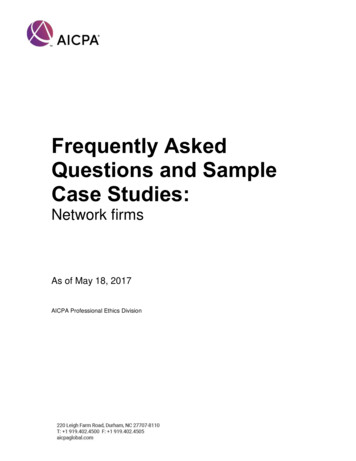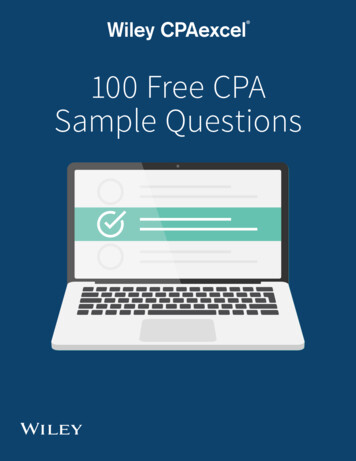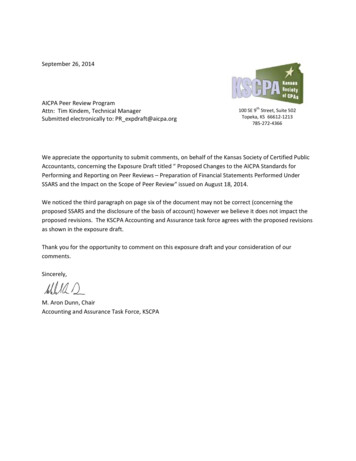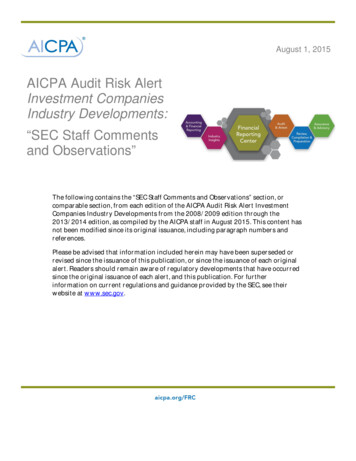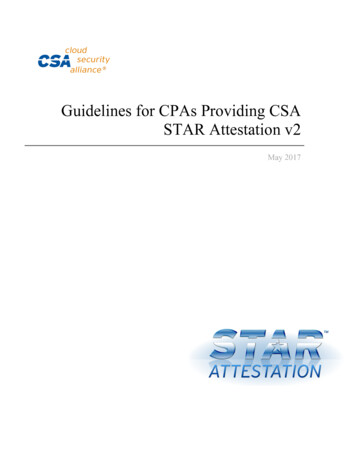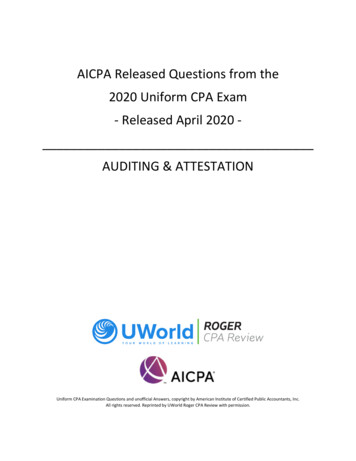
Transcription
AICPA Released Questions from the2020 Uniform CPA Exam- Released April 2020AUDITING & ATTESTATIONUniform CPA Examination Questions and unofficial Answers, copyright by American Institute of Certified Public Accountants, Inc.All rights reserved. Reprinted by UWorld Roger CPA Review with permission.
UWorld Roger CPA Review2020 AICPA Released Questions – AUD2020 AICPA Released Questions for AUDThe Key gives the correct letter answer for each question.Key: AThe numbering system indicates the AICPA Blueprint Representative Task and Skill Level for each question.AUD.CSO.20190701: AUD.001.001.001AUD.SSO.20190701: Remembering and Understanding:1MULTIPLE CHOICE - MODERATEIn which of the following situations would an auditor who is rendering an audit opinion on thefinancial statements of an employee benefit plan that will be filed with the Department ofLabor be considered independent?A.The auditor's spouse has obtained an immaterial direct financial interest in theemployee benefit plan.B.The auditor obtained a material indirect financial interest in the employee benefit plan.C.A member of the auditor's firm was an investment advisor to the employee benefit planduring the period of professional engagement but was not providing services as of thedate of the opinion.D.A member of the auditor's firm was a voting trustee of the plan in a prior year but hassince disassociated from the plan and did not participate in auditing the financialstatements of the plan.An accountant performing audits of employee benefit plans is required to comply with theindependence requirements of the Department of Labor (DOL). The DOL independencerequirements are a bit more restrictive than the AICPA requirements.Three types of relationships can impair an accountant’s independence. The requirements applyto the accountant and the accountant’s firm and relate to the period of the engagement as wellas the period covered by the engagement.Independence is impaired by: Having, or committing to acquiring, any direct financial interest or any material indirectfinancial interest in the plan.Acting as the plan’s, or plan sponsor’s, promoter, underwriter, investment advisor,voting trustee, director, officer, or employee.Maintaining financial records for the plan.Since the member of the auditor's firm was a voting trustee in a prior year and did notparticipate in auditing the plan financial statements in the current year, there is not a breach ofindependence.2
UWorld Roger CPA Review2020 AICPA Released Questions – AUDItem ID:24853Key: DAUD.CSO.20190701: AUD.001.002.003AUD.SSO.20190701: Application:23
UWorld Roger CPA Review2020 AICPA Released Questions – AUDThe primary objective of an auditor when considering the acceptance of an initial auditengagement of a nonissuer is toA.Establish whether the preconditions for an audit are present.B.Agree with management on the timing of tests at interim and year end.C.Limit the auditor's responsibility if management fails to provide written representations.D.Specify the degree to which management intends to rely on the auditor's testing ofinternal controls.Deciding whether to accept an audit engagement will depend on whether the preconditions foran audit have been met. There are two key considerations in making this decision: Determining the acceptability of the financial reporting framework (FRF) being applied.Obtaining management’s agreement that it understands and accepts certainresponsibilities:o Preparation and fair presentation of the financial statements (F/S) in accordancewith the FRF (including all appropriate informative disclosures related to aspecial purpose framework when used to prepare the F/S);o Design, implementation, and maintenance (DIM) of internal control relevant toreliable financial reporting that is free from material misstatement, whether dueto fraud or error; ando Providing the auditor with access to all relevant information of whichmanagement is aware; additional information requested by the auditor; andunrestricted access to entity personnel (no client-imposed scope limit).The auditor will also want to make certain that the F/S are auditable. If the accounting recordsare inadequate, the auditor may not have the ability to gather sufficient appropriate auditevidence and will have to refuse the engagement.Agreeing on the timing of tests and limiting the auditor’s responsibility if management fails toprovide written representations would be addressed in the engagement letter, after theauditor has accepted the engagement. Management does not rely on the auditor’s testing ofinternal control.Item ID:74327Key: AAUD.CSO.20190701: AUD.001.003.001AUD.SSO.20190701: Remembering and Understanding:14
UWorld Roger CPA Review2020 AICPA Released Questions – AUDAn auditor encounters significant difficulties during an audit that are likely to lead to a modifiedopinion. When would it be most appropriate for the auditor to communicate those difficultiesto the audit committee?A.On the report issuance date.B.Early in the audit engagement acceptance process.C.As soon as is practicable during the course of the engagement.D.On the last day of fieldwork.Certain matters should be communicated to those charged with governance. For entities withformal structures, this will generally be the audit committee. Among the matters the auditorshould communicate are (use the mnemonic DISAPPROVE): Disagreements with management about accounting policies or audit procedures.Illegal acts and significant errors discovered during the audit, fraud involving seniormanagement, noncompliance with laws and regulations.Significant accounting policies adopted or changed by management.Adjustments proposed by the auditor with a significant impact on the F/S.Prior discussions with management before acceptance of the engagement.Problems or significant difficulties arising during the audit, if any, in obtaining evidenceand employee cooperation.Responsibilities of the auditor under GAAS to form and express an opinion on whetherthe F/S are prepared, in all material respects, in accordance with the AFRF.Other information discussed or dealt with by management when those charged withgovernance are not all involved in management.Views of the accountant regarding the qualitative aspects of the entity’s significantaccounting policies, estimates, and disclosures.Estimates in the accounting records and the process used to obtain them, including fairvalue estimates, and the basis for the auditor’s conclusion about their reasonableness.Should an auditor encounter significant difficulties during an audit, they should inform the auditcommittee as soon as possible. The audit committee may be able to resolve those difficulties ina timely manner, avoiding the possibility of a modified opinion.Item ID:20443Key: CAUD.CSO.20190701: AUD.001.005.003AUD.SSO.20190701: Remembering and Understanding:15
UWorld Roger CPA Review2020 AICPA Released Questions – AUDWhich of the following individuals would be considered a predecessor auditor?A.A client's accounting employee who audits the company's branches, subsidiaries, orother outlying locations from the company's home office.B.A client's accounting employee responsible for the preparation of the company'sfinancial statements.C.An independent CPA who was engaged to perform but did not complete an audit offinancial statements.D.An independent CPA who is considering accepting an engagement to audit financialstatements.A predecessor auditor is an independent CPA from a different audit firm who conducted anaudit(s) for the client in a prior period, but no longer does so. A successor auditor is theindependent auditor who accepted the current year audit engagement and replaced thepredecessor auditor. A client’s employee would not be independent and therefore could notbe an auditor.Item ID:11269Key: CAUD.CSO.20190701: AUD.001.006.000AUD.SSO.20190701: Remembering and Understanding:16
UWorld Roger CPA Review2020 AICPA Released Questions – AUDWhich of the following internal control activities would not be effective for detectingmisstatements of inventory item pricing schedules?A.Segregation of duties between customer invoicing and inventory valuation.B.Comparison of sales invoices to price lists on a test basis.C.Review of vendor lists for fictitious vendors in the system.D.Comparison of groups of items to sales reports and subsequent investigation of unusualvariances.In obtaining evidence about inventories, the auditor will first evaluate whether there is reasonto believe that inventories are misstated at the financial statement element or accountbalance level. The auditor will apply analytical procedures to determine if the recordedinventory balance seems reasonable.This approach would also be used to obtain evidence that inventory was appropriately priced,(ie, were sales correctly computed). To test for valuation and accuracy of inventory sales, theauditor could perform the following substantive procedures: Determine there is adequate review and supervision of the data entry process to provideassurance that cost and sales amounts of inventory are being input accuratelySales invoices are traced to inventory pricing schedules to determine that correct priceshave been recorded for inventory sales.Compare the relationship of sales to cost of sales and cost of sales to inventories todetermine if the reported amounts seem reasonable. Determine if unusual variances areinvestigated.Ensure there was adequate segregation of duties. Incompatible duties such as valuinginventory on hand and billing customers should be assigned to individuals in separatedepartments to minimize the risk of stealing inventory and then recording fictitious salesto cover the theft.Vendor lists only include information about the supplier, such as contact information. Sincethey do not include inventory price information, reviewing them would not be an effectivemethod for detecting misstatement inventory balances.Item ID:11047Key: CAUD.CSO.20190701: AUD.002.003.002AUD.SSO.20190701: Application:27
UWorld Roger CPA Review2020 AICPA Released Questions – AUDWhich of the following groups within an entity is typically in the best position to perpetrate amaterial -level personnel.The auditor's responsibility is to plan and perform the audit to obtain reasonable assurance thatno errors or acts of fraud have caused the financial statements (F/S) to be materiallymisstated. Fraud is an intentional act by one or more individuals among management, thosecharged with governance, employees, or third parties involving the use of deception thatresults in a misstatement in F/S that are the subject of an audit.Among other things, auditing standards require the auditor to hold a “brainstorming” sessionwith engagement staff to discuss the risks of material misstatements due to fraud, includinghow and where F/S might be susceptible to fraud, how management could perpetrate andconceal fraudulent F/S, and how assets could be misappropriatedManagement is the primary group that can be subject to excessive pressures to meet financialtargets, thus providing motivation and rationalization to commit fraud.Management has the best opportunity to commit and conceal fraud as they not only have dayto-day access to assets, they also have the ability to make adjustments to the financialstatements to conceal the fraud as they are not as monitored or restricted as entry-levelpersonnel.Directors and customers by themselves generally do not have the necessary physical or ITaccess to commit and conceal fraud. However, they could collude with management toperpetrate a fraud.Item ID:14453Key: CAUD.CSO.20190701: AUD.002.003.005AUD.SSO.20190701: Remembering and Understanding:18
UWorld Roger CPA Review2020 AICPA Released Questions – AUDWhich of the following factors affecting the risk associated with a control is not a considerationwhen designing the current-year audit procedures in an audit of internal control over financialreporting for an issuer?A.Whether there have been changes in the operation of a key control since the previousaudit.B.The results of the previous years' testing of the control.C.The nature, timing, and extent of procedures performed in previous audits.D.Whether the control has been documented in flowchart or narrative form.Audit planning involves developing an overall strategy for the expected conduct and scope ofthe audit. The engagement team plans the audit to be responsive to the assessment of the riskof material misstatement based on the auditor’s understanding of the entity and itsenvironment, including its internal control.The steps in Planning an audit include (use the mnemonic BRAINSTOPS to remember anauditor's brain stops if they don't plan out the audit carefully).1. Basic discussions with the client about the nature of the engagement and the client'sbusiness and industry are performed first.2. Review of audit documentation from previous audits performed by the accounting firm or apredecessor auditor.3. Ask about recent developments in the company, such as mergers and new product lines,which will cause the audit to differ from earlier years.4. Interim F/S are analyzed to identify accounts and transactions that differ from expectations(based on factors such as budgets or prior periods).5. Nonaudit personnel of the accounting firm who have provided services (such as taxpreparation) to the client should be identified and consulted to learn more about the client.6. Staffing for the audit should be determined and a meeting held to discuss the engagement.7. Timing of the various audit procedures should be determined.8. Outside assistance needs should be determined, including the use of a specialist and thedetermination of the extent of involvement of the internal auditors of the client.9. Pronouncements reflecting changes in accounting principles and audit standards should beread or reviewed to assist in the development of complete audit programs fitting the uniqueneeds of the client's business and industry.9
UWorld Roger CPA Review2020 AICPA Released Questions – AUD10. Scheduling with the client is needed to coordinate activities.Whether the control has been documented in flowchart or narrative form is not aconsideration. What matters is whether the control can be relied upon to be effective.Item ID:15783Key: DAUD.CSO.20190701: AUD.002.005.003AUD.SSO.20190701: Application:210
UWorld Roger CPA Review2020 AICPA Released Questions – AUDIn order to reduce the risk that the aggregate of undetected misstatements in the groupfinancial statements of a nonissuer exceeds the materiality for the group financial statementsas a whole, an auditor should establish aA.Materiality for the group financial statements that is lower than the componentmateriality.B.Materiality for the group financial statement that exceeds prior-year materiality for thegroup financial statements.C.Component materiality that is lower than the materiality for the group financialstatements.D.Component materiality that is equal to the materiality for the group financialstatements.A CPA firm that audits entities with smaller reporting segments will use component auditors toperform audits at those reporting segments. The group engagement team collects thecomponent auditors' work near the end of the audit engagement and uses it to form an opinionabout the entity's consolidated financial statements.Because each component is only a part (or piece) of the entire consolidated (group) F/S, thecomponent materiality will be smaller in relation to that of the group. The objective is toreduce the risk that the aggregate undetected misstatements in the group exceeds themateriality for the group.For example, suppose materiality for the group is 5% of total assets. If the consolidated totalassets were 100,000, then the group's materiality threshold would be 5,000. This thresholdwould be too large to use for individual components because it allows for misstatements thatwould otherwise be considered material at the component level to go undetected.Supposed the components were as follows: Component A, with total assets of 50,000, materiality ( 50,000 x .05) 2,500.Component B, with total assets of 25,000, materiality ( 25,000 x .05) 1,250.Notice that materiality thresholds for each component are much smaller than the 5,000 groupmateriality. This allows for smaller misstatements to be detected, thus, reducing the risk that inthe aggregate, undetected misstatements exceed the group's materiality.Item ID:19171Key: CAUD.CSO.20190701: AUD.002.006.001AUD.SSO.20190701: Remembering and Understanding:111
UWorld Roger CPA Review2020 AICPA Released Questions – AUDWhen assessing an internal auditor's objectivity, the independent auditor shouldA.Examine workpapers of the internal auditor to verify evidence of supervision andreview.B.Review the internal auditor's current audit plan, including the nature, timing, and extentof audit work.C.Determine the educational level and the professional experience of the internal auditor.D.Ascertain the organization level to which the internal audit function reports.In evaluating the objectivity of internal auditors (I/A), the external auditor will determinewhether I/A are free of bias or conflicts of interests, and whether they are subject to the undueinfluence of others such that their professional judgment may be overridden or otherwiseaffected.The external auditor should keep in mind that neither the I/A function nor the I/A themselvescan be independent in relation to the entity. Several factors that affect the objectivity of I/Ainclude: The level of authority within the organization to which internal auditors report.Objectivity is enhanced when internal auditors report to those charged with governanceor an officer with appropriate authority, as opposed to management.Participation in management or operations may impair objectivity as internal auditorsmay end up responsible for drawing conclusions about their own performance.Constraints or restrictions on internal auditors, such as restrictions on communicationswith the external auditors, impairs objectivity.The level at which employment and remuneration decisions related to internal auditorsare made.Item ID:10849Key: DAUD.CSO.20190701: AUD.002.007.000AUD.SSO.20190701: Remembering and Understanding:112
UWorld Roger CPA Review2020 AICPA Released Questions – AUDWhich of the following is a characteristic of nonstatistical sampling?A.It uses the laws of probability to select a sample.B.It requires each item to have an equal probability of being selected.C.It requires judgment to select a sample.D.It is preferable for an audit-level engagement.Statistical sampling refers to the use of quantitative measures of the risks the auditor is takingin the use of sampling. Formulas are used to determine the sample size necessary to achieve aspecified level of risk of the sample results not being consistent with the entire population.Nonstatistical sampling relies on the auditor’s judgment in determining sample size, itemsselected for a test group, and how the results are interpreted. It is often used when statisticalsampling is not efficient or effective. For example, selecting inventory items for testing inconjunction with the year-end physical inventory. It can also be used in areas whereinformation is highly confidential, such as pending lawsuit outcomes.Item ID:13857Key: CAUD.CSO.20190701: AUD.003.002.000AUD.SSO.20190701: Remembering and Understanding:113
UWorld Roger CPA Review2020 AICPA Released Questions – AUDAn auditor is testing a client's pension benefit obligation. Which of the following types ofevidence would be most appropriate for determining that the financial statement balance isfairly stated?A.A client-prepared schedule showing accounting entries made to the general ledgerbalance.B.An actuarial valuation obtained by an outside firm.C.Confirmation of payments received by retirees.D.Analytical procedures that compare last year's balance to this year's balance.AU-C 500 defines audit evidence as all the information used by the auditor in arriving at theconclusions on which the audit opinion is based, including the information contained in theaccounting records underlying the financial statements and other information.The reliability of audit evidence is directly related to the source from which it is obtained, theconditions under which it is developed and acquired, and its form. Evidence obtained by anauditor, ranking from the most reliable to the least, may come from the following sources:1. Audit evidence may be obtained directly by the auditor, such as through the observation ofthe application of a control or walking around the factory facilities to inspect manufacturingequipment. This is more reliable than audit evidence obtained indirectly or by inference, suchas through an inquiry about the application of a control.2. The reliability of audit evidence is increased when it is obtained from independent sourcesoutside the entity, such as confirmations received directly by the auditor from customers of theclient. Comparing current year to prior year balances would therefore not be the strongestform of evidence as it relies on information provided by the client, not an independent source.3. Evidence that originated outside the entity but is provided by the entity, such as a customerinvoice or a bank statement provided to the auditor by the client, is more reliable thaninformation that is both received from the entity and prepared by the entity.4. The reliability of inside audit evidence that is generated internally is increased when therelated controls, including those imposed by the entity, over its preparation and maintenance,are effective.5. Audit evidence in documentary form, whether paper, electronic, or other medium, is morereliable than evidence obtained orally. A contemporaneously written record of a meeting, forexample, is more reliable than a subsequent oral representation of the matters discussed.14
UWorld Roger CPA Review2020 AICPA Released Questions – AUDItem ID:13537Key: BAUD.CSO.20190701: AUD.003.003.006AUD.SSO.20190701: Application:215
UWorld Roger CPA Review2020 AICPA Released Questions – AUDWhich of the following would provide an auditor of a nonissuer with the best evidence of fairvalue pertaining to a client's investments in derivative instruments that are listed on a nationalexchange and disclosed at fair value?A.The client's personnel who trade the derivative instruments.B.Quoted market prices.C.Documents related to the original purchase of the derivative instruments.D.Estimates of fair value provided by broker-dealers.An entity uses derivatives as hedges to protect itself against various risks that may be inherentin the assets or liabilities they hold, in anticipated transactions, or other aspects of theirbusiness. The purpose of the hedge is to shift the risk to a counterparty.Since derivatives are required to be reported at fair value, the auditor is required to evaluatewhether the fair values of investments in derivatives have been determined appropriately,using an acceptable valuation method.The best substantive procedures to test valuation assertions based on fair value include: Obtaining quoted market prices on exchanges when available.Obtaining quoted market prices from broker-dealers for unlisted securities.Obtaining estimates, including those using models like Black-Scholes.Item ID:18813Key: BAUD.CSO.20190701: AUD.003.004.002AUD.SSO.20190701: Remembering and Understanding:116
UWorld Roger CPA Review2020 AICPA Released Questions – AUDWith respect to litigation involving a nonissuer that could give rise to a risk of materialmisstatement, an auditor should obtain audit evidence relevant to each of the followingmatters, exceptA.The period in which the underlying cause for legal action occurred.B.The amount or range of potential loss resulting from the litigation.C.The degree of probability of an unfavorable outcome.D.The objectivity and experience of the entity's legal counsel.Contingencies represent gains or losses that may or may not occur in the future as a result ofan event that has already occurred or an existing condition. For example, contingencies mayresult from asserted lawsuits as well as conditions that may result in a future lawsuit.AU-C 501 requires the auditor to perform audit procedures to determine if there arecontingencies and, if so, if they are properly accounted for and disclosed. As part of the auditevidence related to contingencies, the auditor will obtain an attorney’s letter from eachattorney with which the client did business relevant to any litigation, claims, or assessments.Ordinarily, management will provide the following information for the letter: (1) the nature andtiming of the litigation, (2) the progress of the case to date, (3) how management is respondingor intends to respond to the litigation (for example, to contest the case vigorously or to seek anout-of-court settlement), (4) an evaluation (ie, degree of probability) of the likelihood of anunfavorable outcome, and (5) an estimate of the amount or range of potential loss.The attorney is asked to furnish the auditor with any explanation that they consider necessaryto supplement management’s information.Item ID:18333Key: DAUD.CSO.20190701: AUD.003.004.004AUD.SSO.20190701: Application:217
UWorld Roger CPA Review2020 AICPA Released Questions – AUDWhich of the following qualitative factors would an auditor consider most relevant to theconsideration of whether a discovered misstatement is material?A.The audit team found a misstatement that, if recorded, affects the client's compliancewith loan covenants.B.The audit team found only one misstatement due to an error made by a new clientemployee.C.The audit team found a miscalculation in the client's tax filing that does not affect theclient's current financial statements but has the effect of increasing its tax liability infuture periods.D.The company recently emerged from bankruptcy after receiving additional bankfinancing.The auditor plans the audit to obtain reasonable assurance of detecting misstatements thatcould be large enough, individually or in the aggregate, to be material to the financialstatements (F/S). Materiality is based on auditor’s judgment.Materiality judgments involve both quantitative and qualitative considerations.For planning purposes, materiality is measured using the smallest aggregate level.There is an inverse relationship between audit risk and the materiality consideration.Misstatements and omissions are considered material if they are expected to, individually or inthe aggregate, influence the decisions a user will make based on the F/S. Separate lowermateriality levels may be established for specific classes of transactions, account balances, ordisclosures. For example, searching for violations of loan covenants may have a lower testinglevel due to the risk of debt being called by the financial institution.One mistake by a new employee should not increase an auditor’s concern about the risk of amaterial misstatement (RMM). Errors are to be expected and can easily be corrected. Amiscalculation on a tax return affecting future periods clearly has no impact on the currentyear. Emerging from bankruptcy will be a concern to auditors, but it is not indicative of a higherRMM.Item ID:12909Key: AAUD.CSO.20190701: AUD.003.005.000AUD.SSO.20190701: Application:218
UWorld Roger CPA Review2020 AICPA Released Questions – AUDAn accountant is reporting on comparative financial statements that include year 1 and year 2as part of a review engagement for a nonissuer. Current management was not in place untilhalfway through year 2. At the completion of the year 2 review, the accountant should obtainrepresentations from management that coverA.The second half of year 2, but no other periods, from current management.B.Year 1, but not year 2, from current management.C.Both year 1 and year 2 from current management.D.Year 1 and the first half of year 2 from prior management and the second half of year 2from current management.When reporting on a review of comparative F/S and there are no departures from theapplicable financial reporting framework, nor any other circumstances requiring modification ofthe report, the only change to the report will be reference to all periods included and the useof plurals when referring to the reviews performed and the statements reviewed.In other words, at the completion of the year 2 review, the accountant should obtainrepresentations from current management that cover both year 1 and year 2.Item ID:16017Key: CAUD.CSO.20190701: AUD.003.006.000AUD.SSO.20190701: Application:219
UWorld Roger CPA Review2020 AICPA Released Questions – AUDSubsequent to the issuance of the audit report for the final year of a three-year contract, a factis discovered that may have affected the final year's report. Which of the following actions isthe auditor required to take?A.The auditor is not required to do anything because the auditor was discharged forreasons other than professional misconduct after the audited financial statements wereissued.B.The auditor is not required to do anything because once the auditor has reported onaudited financial statements, the auditor has no responsibility to carry out anyretrospective review of the workpapers or show the effect of any newly discovered factson them.C.The auditor is required to determine whether the information is reliable and whetherthe facts existed at the date of the report.D.The auditor is required to reissue the auditor's report and to reference discovery of thefact.Once the audit report has been issued, the auditor normally has no ongoing responsibility toupdate the report for events occurring after that, including the resolution of lawsuits that wereproperly disclosed.A problem
UWorld Roger CPA Review 2020 AICPA Released Questions - AUD 2 2020 AICPA Released Questions for AUD The Key gives the correct letter answer for each question. Key: A The numbering system indicates the AICPA Blueprint Representative Task and Skill Level for each question. AUD.CSO.20190701: AUD.001.001.001



